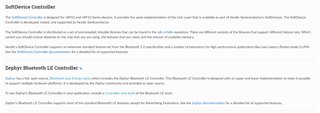Hi, All,
I saw the following description in the nRF Connect SDK documentation you provided:

That means there are two kinds of controllers on an NCS: Zephyr BLE controller and Nordic softdevice controller.
So I have a few questions about these two controllers:
1. What's the main difference between the two ?
2. Or what is the functional difference between the two ? What function does one have that the other does not ?
3. How different are they in terms of tailoring in order to optimize memory usage? Which has the advantage ?
These determine which controller we use.
Hope to get your reply soon, thank you !
